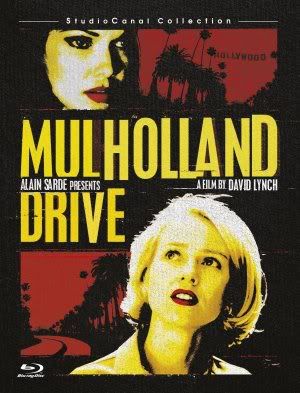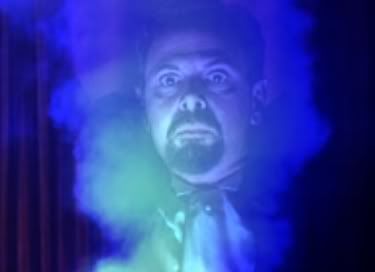 |
| Fig. 1 Mulholland Drive poster. |

 |
| Fig. 2 Betty and Rita. |
 |
| Fig. 3 Magician at Club Silencio. |
It is the audience's awareness that they are watching something fictional and constructed that is particularly interesting. The director, David Lynch, uses many different narrative and visual techniques to wake the audience up and bring them into the reality he wants them to experience. Heidi M. Schlipphacke belives that "quintessentially postmodern films such as Mulholand Drive...exhibit...a non-linear, sometimes dream like narrative structure, multiple narratives, and a level of open-endedness that pose as many questions as they answer." (Schlipphacke, 2010:125) This 'open-endedness' is something of a speciality in this film. As mentioned previously, the audience can feel as if they have sat through two very separate narratives, linked together only by the familiar faces, rather than the supposed reality of the situations. Both of these narratives have ways in which they make the audience aware that these events are fictional, and one is the use of dream-like sequences. The most prominent example of this is when the two women visit Club Silencio after Rita mutters about it in her sleep. It is this scene that marks the beginning of the end for the detective/fairy-tale narrative as this is where Betty (who later becomes Diane) begins to 'wake up'. Elena del Rio divulged that "This scene functions as the kernel of both dream and film, the point Diane's dream reaches at which it has no other choice but to self-destruct, thereby anticipating her own demise as well as the film's." (Del Río, 2008:181) This is when the illusion of the film's first narrative dies away, and it metamorphoses into a much darker state. Club Silencio is opened by a magician; he tells the audience that there is no orchestra, that everything is run from a tape player, that everything here is an illusion. Del Rio goes on to explain that "Here, the unravelling of illusion performed by the showman does not lead to Brechtian enlightenment*, but rather to an experience of raw and unmotivated affect that leaves characters and viewers in a state of perceptual and affective shock." (Del Río, 2008:21) Club Silencio is acting as an alarm bell, pointing out to the audience that everything they see is an illusion while simultaneously drawing them in with an incredibly emotional, but false, performance from a female singer. It is this lip syncing that "exemplifies Lynch's insight into the affective value and power of the false." (Del Río, 2008:183), giving so much power and influence to something that is in fact a falsification makes the audience feel foolish. They have been pulled into the realism of the performance despite all preliminary warnings and that is just so clever.
Mulholland Drive was a spectacular example of how illusion can manipulate an audience, and how 'breaking the fourth wall', between the fiction on screen and those watching it, can create a bold sense of confusion and fascination. The audience is definitely left puzzled and as Schlipphacke aptly puts it: "films such as Lynch's Mulholland Drive (2001) begin and end in a haze of questions and abstractions" (Schlipphacke, 2010:125). This is the perfect description of the enigma that was Mulholland Drive, and though it is nice for the audience to get some closure, sometimes you just want something to fuzz up everything you thought you understood.
Footnote:
*"Epic Theatre proposed that a play should not cause the spectator to identify emotionally with the characters or action before him or her, but should instead provoke rational self-reflection and a critical view of the action on the stage. Brecht thought that the experience of a climactic catharsis of emotion left an audience complacent. Instead, he wanted his audiences to adopt a critical perspective in order to recognise social injustice and exploitation and to be moved to go forth from the theatre and effect change in the world outside."
- Wikipedia
List of Illustrations
Figure 1. Mulholland Drive poster. At: http://www.movieposterdb.com/posters/10_08/2001/166924/l_166924_b8c1bb3a.jpg (Accessed on: 12/10/11)
Bibliography
Del Río, Elena (2008) Deleuze and the cinemas of performance: powers of affection. UK: Edinburgh University Press Ltd.
Booker, M. Keith (2007) Postmodern Hollywood: what's new in film and why it makes us feel so strange.USA: Praeger Publishers
Schlipphacke, Heidi M. (2010) Nostalgia after Nazism: history, home, and affect in German and Austrian Literature and Film. USA: Bucknell University Press.
Sim, Stuart (2001) The Routledge companion to postmodernism. UK: Routledge.
Figure 2. Mulholland Drive (2001) Betty and Rita. At: http://www.synoptique.ca/images/uploads/articles/s6_mull32.jpg (Accessed on: 12/10/11)
Figure 2. Mulholland Drive (2001) Magician at Club Silencio: http://hypebeast.com/blog/yoon/files/2011/06/md-magician-smoke-sized.jpg (Accessed on: 12/10/11)
Bibliography
Del Río, Elena (2008) Deleuze and the cinemas of performance: powers of affection. UK: Edinburgh University Press Ltd.
Booker, M. Keith (2007) Postmodern Hollywood: what's new in film and why it makes us feel so strange.USA: Praeger Publishers
Schlipphacke, Heidi M. (2010) Nostalgia after Nazism: history, home, and affect in German and Austrian Literature and Film. USA: Bucknell University Press.
Sim, Stuart (2001) The Routledge companion to postmodernism. UK: Routledge.

Brilliant review, Molly.
ReplyDeleteI suppose if Federico Fellini's 8 1/2 tells us everything we need to know about making films, then Mullholland Drive is the film that tells us everything we need to know about watching films. How we perceive 'reality' within the universe of a film and how we are ultimately puppets to the whims of a filmmaker.
On the MA we just read a text that dealt with the idea that 'silence' is the key construct of language. I find it interesting that MD too uses this idea with the 'Silencio' sequence. The language of film becomes broken in a single moment, leaving nothingness. However, that break, the empty void reveals to us the construction of cinema...
Something like that anyway. Sorry if it seems like I'm talking absolute nonsense!
Ha! Thank you! :D
ReplyDeleteYou're not talking nonsense at all, that sounds pretty cool to me! I'm glad I made sense to be honest, there was so much to say I wasn't really sure if I was just waffling on :P
This tutor is in pig-heaven - look, there's Molly (with a very satisfying review and increasing command of postmodern hi-jinx), and look, there's Tom, dripping profundity about how absence births presence. Really, I couldn't be any happier!
ReplyDelete